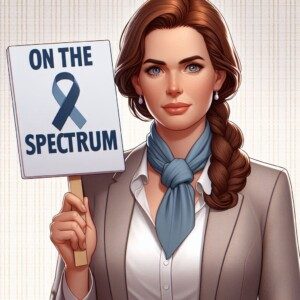“All the adult autism diagnoses getting thrown around is an insult to kids with severe autism. You should see REAL autism.”
If my meta description for this post has your blood sizzling, I’m glad, because this means there are other Autistics such as myself who found the commenter’s statement ignorant.
The meta description is a shortened version of an actual comment to an article about a woman who got her ASD diagnosis at age 37.
Below is the screenshot of the comment.

Who is “C Hig” to declare what “real” autism is or isn’t?
Presumably, this person has a child with a Level 3 autism diagnosis.
An analogy to C Hig’s line of logic would be, “What’s with all the people getting diagnosed with sunburns? You should see REAL burn victims from a fire.”
I’ll assume that C Hig has no concept of Level 1, Level 2 and Level 3 autism.
- Level 1 = minimal support needs.
- Level 2 = substantial support needs.
- Level 3 = very substantial support needs.
These definitions come from the mental health specialist’s handbook, DSM-5.
Even within each level there is a spectrum of support needs.
I have a clinical diagnosis of Level 1 autism – given in middle age.
I am just as much an Autistic as C Hig’s “severely” autistic child.
The difference is that I have minimal support needs. But it’s also possible that throughout the day, I stim as much as a child with Level 3 autism.
One need not be severely incapacitated to hit all the required criteria for an autism diagnosis.
C Hig and like-minded people really need to do their homework.
People who’ve been diagnosed with Level 1 autism in adulthood weren’t free of problems all throughout the years leading up to their diagnosis.
Many, indeed, such as myself, “made it to” their adult age of autism diagnosis “with no help.”
But that doesn’t mean we didn’t have ongoing issues.
For many individuals who were diagnosed with Level 1 autism in adulthood, the following challenges were real:
• Being bullied, ridiculed or ostracized throughout their school years for being different.
• Being singled out by teachers as the odd kid and hence, treated sourly by those teachers despite that child being well-behaved and getting good grades.
• Sensory issues that can disrupt one’s day or frequently interfere with community outings.
• Difficulty making friends, or, keeping those friendships.
• Confusion or bewilderment in social environments due to impairment with reading nonverbal social cues or picking up on typical communication.
• Studying the behavior of peers to get good at mimicking them – being unauthentic and fake just to fit in.
This is called masking and for some late-diagnosed Autistics, has led to career-ending burnouts.
• Difficulty in the dating/romance arena.
• Trouble fitting in on the job; getting fired for not fitting in despite being productive.
• Difficulty getting a job due to differences in communication and mis-reading social cues.
Not all late-diagnosed autistic people have had every single one of these experiences, but most of these experiences resonate with late-diagnosed people.
So yes, many Level 1’s make it well into adulthood – including a college degree, a professional job, living independently, marrying and even having children – without assistance beyond what typical young adults spreading their wings seek out.
Some late-diagnosed Autists even end up in mental health professions including working with autistic kids – years before they begin realizing that they, too, are on the Spectrum.
“Real” autism is a diagnosis of autism given by a psychologist or neuropsychologist who’s trained to yield comprehensive autism assessments.
Many late-diagnosed Autistics had past incorrect diagnoses, or incomplete diagnoses.
Conditions of misdiagnoses are usually ADHD, OCD, a personality disorder, panic attack disorder or bipolar disorder.
An example of an incomplete diagnosis might be someone correctly diagnosed in childhood with ADHD, but the examiner missed the autism.
Bash the Stereotypes of Autism

C Hig apparently believes that real autism means lying on the floor for long periods and flapping one’s hand before their face, being unable to have a simple conversation, having ferocious meltdowns several times a week, and needing help getting dressed.
Now certainly, there’s probably some adults with minimal-support-needs autism who, when feeling stressed, might take to lying on their bedroom floor and waving their hand before their face – a stim for self-regulation. But they would do this only in private by themselves.
Hopefully you get the picture: Those who believe that autism can only present as a severe form have been brainwashed by stereotypes.
- We aren’t all Rain Man.
- We aren’t all Tommy Westphall – the boy with autism on the hit TV show “St. Elsewhere” who couldn’t speak and spent hours shaking a snow globe.
- Some of us, actually, are more like Mr. Spock or T’Pol, Commander Data, Temperance Brennan, Sherlock Holmes and of course, Sheldon Cooper.
Hey C Hig, did you know that autism is a Spectrum?
The official name of the condition, which is lifelong and NOT caused by bad parenting or vaccines, is Autism Spectrum Disorder.
ASD comes with many strengths!
- Ability to think deeply with intense focus
- Analytical prowess
- Detail oriented
- Natural resistance to peer pressure to do the wrong thing
- Natural resistance to jumping on the latest absurd bandwagon; lack of herd mentality or a follow-the-crowd mindset
- Often ARTistic (drawing, painting, music, writing, poetry, crafts)
- Can quickly assimilate a large volume of information on their latest passion
- Tendency to make major decisions based on facts and logic rather than emotions and feelings
- Direct and straightforward; don’t play mind games
- A knack for precision and exactness
- Very loyal to friends
 Lorra Garrick has been covering medical and fitness topics for many years, having written thousands of articles for print magazines and websites, including as a ghostwriter. She’s also a former ACE-certified personal trainer. In 2022 she received a diagnosis of Level 1 Autism Spectrum Disorder and subsequently has developed an intense interest in ASD.
Lorra Garrick has been covering medical and fitness topics for many years, having written thousands of articles for print magazines and websites, including as a ghostwriter. She’s also a former ACE-certified personal trainer. In 2022 she received a diagnosis of Level 1 Autism Spectrum Disorder and subsequently has developed an intense interest in ASD.
.










































